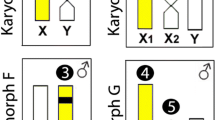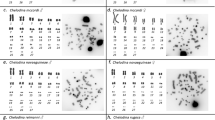Abstract
Cytogenetic studies were carried out in the fish, Hoplias malabaricus, from the Parque Florestal do Rio Doce (Brazil). This population is characterized by 2n = 42 chromosomes for both males and females and an XX/XY sex chromosome system, confirmed through several banding methods. Females show 24 metacentric, 16 submetacentric and 2 subtelocentric chromosomes. Males show 24 metacentric, 17 submetacentric and 1 subtelocentric chromosomes. While the X chromosome is easily recognized (the only subtelocentric element), the Y chromosome is somewhat difficult to identify but appears to correspond to the smallest submetacentric in the male karyotype. In-situ hybridization with an 18S rDNA probe showed 10 well-labeled chromosomes, including the X chromosome. The 5S rDNA is interstitially located in a single metacentric pair independent of the 18S rDNA sites. The NOR on the X chromosome is always active and occurs adjacent to a heterochromatic distal segment on the long arm. Variations in size of the NORs and/or heterochromatic segment correspond to a polymorphic size condition observed in the X chromosome. The present results confirm the XX/XY sex chromosome system in the population analyzed as well as a new cytotype in the Hoplias malabaricus group.
Similar content being viewed by others
References
Artoni RF (1999) Citogenética do sistema de cromossomos sexuais ZZ/ZW no gênero Thriportheus (Pisces, Characidae). PhD thesis. Universidade Federal de são Carlos, Brazil.
Bertollo LAC (1996) The nucleolar organizer regions of Erythrinidae fish. An uncommon situation in the genus Hoplias. Cytologia 61: 75–81.
Bertollo LAC, Takahashi CS, Moreira-Filho O (1979) Karyotypic studies of two allopatric populations of the genus Hoplias (Pisces, Erythrinidae). Brazil J Genet 2: 17–37.
Bertollo LAC, Takahashi CS, Moreira-Filho O (1983) Multiple sex chromosomes in the genus Hoplias (Pisces, Erythrinidae). Cytologia 48: 1–12.
Bertollo LAC, Moreira-Filho O, Galetti Jr PM (1986) Cytogenetics and taxonomy: consideration based on chromosome studies of freshwater fish. J Fish Biol 28: 153–159.
Bertollo LAC, Fontes MS, Fenocchio AS, Cano J (1997a) The X1X2Y sex chromosome system in the fish Hoplias malabaricus. I. G-, C-and chromosome replication banding. Chromosome Res 5: 493–494.
Bertollo LC, Moreira-Filho O, Fontes MS (1997b) Karyotypic diversity and distribution in Hoplias malabaricus (Pisces, Erythrinidae): Cytotypes with 2n = 40 chromosomes. Brazil J Genet 20: 237–242.
Chen TR, Ebeling AW (1966) Probable male heterogamety in the deep-sea fish Bathylagus wesethi (Teleostei: Bathylagidae). Chromosoma 18: 88–89.
De Meis MRM (1977) As unidades morfoestratigráficas neoquaternárias do médio Vale do Rio Doce. Ann Acad Brasil Ciênc 49: 37–50.
Derga JA, Bertollo LAC (1990) Karyotypic diversification in Hoplias malabaricus (Osteichthyes, Erythrinidae) of São Francisco and Alto Paraná Basin, Brazil. Brazil J Genet 13: 755–766.
Donahue WHA (1974) A karyotypic study of three species of rajiformes (Chondrichthyes, Pisces). Can J Genet Cytol 16: 201–211.
Ebeling AW, Chen TR (1970) Heterogamety in teleostean fishes. Trans Am Fish Soc 99: 131–138.
Ferreira RHR, Fonseca CG, Bertollo LAC, Foresti F (1989) Cytogenetics of fishes from Parque Florestal do Rio Doce (MG). I. Preliminary study of “Hoplias malabaricus” (Pisces, Eryhtrinidae) from Lagoa Carioca and Lagoa dos Patos. Brazil J Genet 12: 219–226.
Gold JR, Li YC, Shipley NS, Powers PD (1990) Improved methods for working with fish chromosomes with a review of metaphase chromosome banding. J Fish Biol 37: 563–575.
Goodpasture C, Bloom SE (1975) Visualization of nucleolar organizer regions in mammalian chromosome using silver staining. Chromosoma 53: 37–50.
Hizume M (1994) Allodiploid nature of Allium wakegi Araki revealed by genomic in situ hybridization and localization of 5S and 18S rDNAs. Jpn J Genet 69: 407–415.
Howell WM, Black DA (1979) Location of the nucleolus organizer regions on the sex chromosomes of the banded killifish, Fundulus diaphanus. Copeia 3: 544–546.
Howell WM, Black DA (1980) Controlled silver-staining of nucleolus organizer region with a protective colloidal developer: a 1-step method. Experientia 36: 1014–1015.
Lopez PA, Fenocchio AS (1994) Confirmation of two different cytotypes for the neotropical fish Hoplias malabaricus Gill 1903 (Characiformes). Cytobios 80: 217–221.
Maddock MB, Schwartz FJ (1996) Elasmobranch cytogenetics: methods and sex chromosomes. Bull Mar Sci 58: 147–155.
Martínez JL, Morán P, García-Vázquez E, Pendás AM (1996) Chromosomal localization of the major 5S rRNA genes in the European eel (Anguilla anguilla). Cytogenet Cell Genet 73: 149–153.
Martins C, Galetti Jr PM (1999) Chromosomal localization of 5S rDNA genes in Leporinus fish (Anostomidae, Characiformes). Chromosome Res 7: 363–367.
Morán P. Martínez JL, García-Vázquez E, Pendas AM (1996) Sex chromosome linkage of 5S rDNA in rainbow trout (Oncorhynchus mykiss). Cytogenet Cell Genet 75: 145–150.
Moreira-Filho O, Bertollo LAC, Galetti Jr P (1993) Distribution of sex chromosome mechanisms in neotropical fish and description of a ZZ/ZW system in Parodon hilarii (Parodondidae). Caryologia 46: 115–125.
Murakami M, Fujitani H (1998) Characterization of repetitive DNA sequences carrying 5S rDNA of the triploid ginbuna (Japanese silver crucian carp, Carassius auratus langsdorfi). Genes Genet Syst 73: 9–20.
Oliveira C, Almeida-Toledo LF, Foresti F, Britski HA, Almeida-Toledo Filho S (1988) Chromosome formulae of neotropical freshwater fishes. Brazil J Genet 11: 577–624.
Pendas AM, Morán P, Freije JP, Garcia-Vazquez E (1994) Chromosomal mapping and nucleotide sequence of two tandem repeats of Atlantic salmon 5S rDNA. Cytogenet Cell Genet 67: 31–36.
Reed KM, Phillips RB (1997) Polymorphism of the nucleolus organizer region (NOR) on the putative sex chromosomes of Arctic char (Salvelinus alpinus) is not sex related. Chromosome Res 5: 221–227.
Sajdak SL, Reed KM, Phillips RB (1998) Intraindividual and interspecies variation in the 5S rDNA of coregonid fish. J Mol Evol 46: 680–688.
Schmid M (1980) Chromosome banding in Amphibia. IV. Differentiation of GC-and AT-rich chromosome regions in Anura. Chromosoma 77: 83–103.
Schmid M, Haaf T, Geile B, Sims S (1983) Chromosome banding in Amphibia. VIII. An unusual XY/XX sex chromosome system in Gastrotheca riobambae (Anura, Hylidae). Chromosoma 88: 69–82.
Sumner AT (1972) A simple technique for demonstrating centromeric heterochromatin. Exp Cell Res 75: 304–306.
Author information
Authors and Affiliations
Rights and permissions
About this article
Cite this article
Born, G.G., Bertollo, L.A.C. An XX/XY Sex Chromosome System in a Fish Species, Hoplias malabaricus, with a Polymorphic NOR-Bearing X Chromosome. Chromosome Res 8, 111–118 (2000). https://doi.org/10.1023/A:1009238402051
Issue Date:
DOI: https://doi.org/10.1023/A:1009238402051




